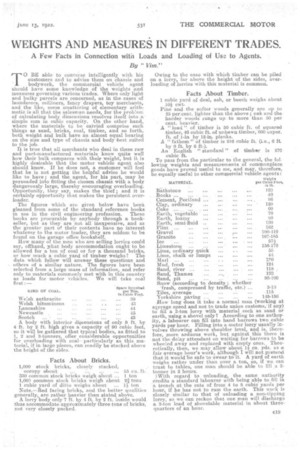WEIGHTS AND MEASURES IN DIFFERENT TRADES.
Page 17

If you've noticed an error in this article please click here to report it so we can fix it.
A Few Facts in Connection with Loads and Loading of Use to Agents.
By " Vim."
T0 BE able to converse intelligently with his . customers and to advise them on chassis and bodywork, the coinnaereial vehicle agent should have some knowledge of the weights and measures governing various trades. Where only light and bulky parcels are concerned, as in the cases of launderers, milliners, fancy drapers, toy merchants and the like, some smattering of elementary arithmetic is all that the salesman needs, for the problem of calculating body dimensions resolves itself into ..a • simple sum in cubic capacity. On the other hand, where the materials to be carried comprise such things as sand, bricks, coal, timber, and so forth, both weight and bulk have an almost equal bearing on the size and type of chassis and body best suited to the job, rt is true that all merchants who deal in these raw and part-manufactured materials knew quite well how their bulk compares with their weight, but it is highly desirable that the motor vehicle agent also should know. If he does not, a customer will feel that he is not getting the helpful advice he would like to have ; and the agent, for his part, may be persuaded into fitting the chosen chassis with a body dangerously large, thereby encouraging overloading. Opportunity, they say, makes the thief ; and it is certainly opportunity that makes the persistent overloader.
The figures which are given below have been gleaned from some of the standard reference books in use in the civil engineering profession. These books are procurable by anybody through a bookseller, but as they are not all inexpensive, and as the greater part of their contents have no interest whatever to the motor trader, they are seldom to be found on the garage office bookshelf.
How many of the men who are selling lorries could say, offhand, what body accommodation ought to be allowed for a-ton of coal or for a thousand bricks, or how much a cubic yard of timber weighs? The data which follow will answer these questions and others of a similar nature. The figures have been selected from a large mass of information, and refer only to materials commonly met with in this country as loads for motor vehicles. We will take coal first :— A body with interior dipiensions of only 9 ft. by 4 -ft, by 2 ft. high gives a capacity of 90 cubic feet, so it will be gathered that typical bodies, as fitted to 1, 2 and 3-tonners, offer considerable opportunities for overloading with maiparticularly as this material, if in largo pieces, can readily be stacked above the height of the sides.
Facts About Bricks.
1,000 stock bricks, closely stacked, occupy about 55 cu.
330 common stock bricks weigh about 1 ton 1,000 common stock bricks weigh about 2/ tons 1 cubic yard of ditto weighs about 14 ton
Note.—Red facing bricks, and the bettea qualities, generally, are rather heavier than stated above.
A lorry body only 7 ft. by 4 ft. by 2 ft. inside would thus accommodate approximately three tons of bricks, not very closely packed. Owing to the ease with which timber can be piled on a lorry, far above the height of the sides, overloading of lorries with this material is common.
Facts About Timber.
1 cubic yard of deal, ash, or beech weighs a-bout 10i• cwt.
Pine and the softer woods generally are op to • 25 percent. lighter than the above ; oak and the harder woods range up to more than 50 per cent. heavier.
A " load 22. of timber is 50 cubic ft. of squared timber, 40 cubic ft. of tuih.ewn timber, '600 super. ft of-l-in by 12-in. planks.
A "fathom " of timber is 216 cubic ft. (i.e., 6 ft. by 6 ft. by 0 ft.). An English " standard " of timbor is 270 cubic ft.
To pass from the particular to the general, the following weights and measurements of commonplace goods have proved useful to me, and may, therefore, be equally useful to other commercial vehicle agents :
'fresh, compressed by traffic, etc.) ... 3-10
Tiles, average • .• 115
Yorkshire paving ... ••• ••• 145-156 .1-low long does it take a normal man (working at ayerage speed and not to trade union customs,if any) to fill a 3-ton lorry with material such as sand or earth, using a shovel only7 According to one authority, a labourer can fill into hand barrows two cubic yards per hoar. Filling into a. motor lorry usually involves throwing above shoulder level, and is, therefore, more arduous work, but against this there is not the delay attendant on waiting for barrows to be wheeled .away and replaced with empty ones. Theoretically, then, we may allow about i4 en. yds. as a fair average hour's work, although I will not pretend that it would 'be safe to swear to it. A yard of earth weighs rather under than over a ton so, if we can trust to tables, one man should be Ale to all _a 3tonner in 2 hours.
With regard to unloading, the same authority
credits a standard labourer with being able to fib in .a trench at the rate of from 4 to 5 cubicyards per hour, if he has not to ram the earth. This work is closely similar to that of unloading a non-tipping lorry, so we can reckon that one man will discharge a 3-ton load of shovelablo material in about threequarters of an hour.


































